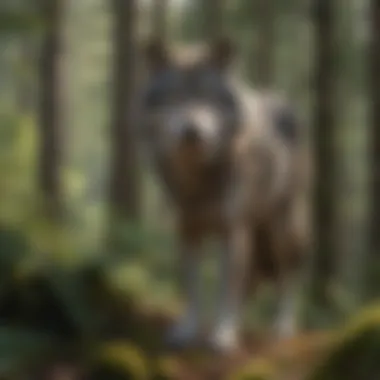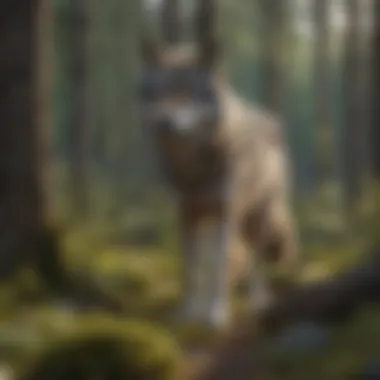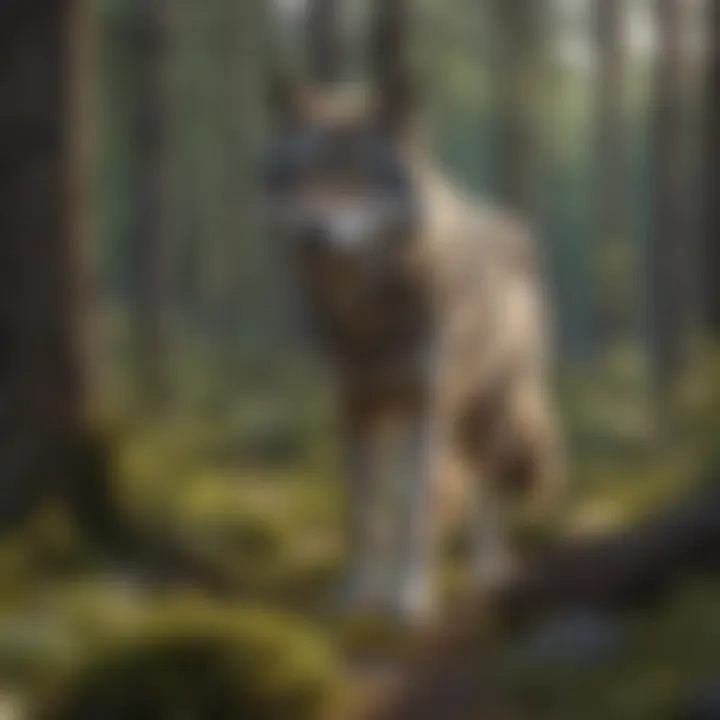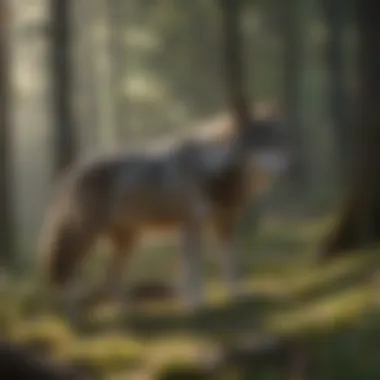Gray Wolf Habitat: Exploring Ecosystem Dynamics


Intro
The gray wolf, a creature steeped in folklore and ecological significance, roams across various habitats in North America, Europe, and parts of Asia. Their existence encapsulates a complex web of interdependencies within different ecosystems. Understanding the dynamics of their habitat is not just an academic exercise; it holds critical implications for biodiversity and conservation strategies, especially in the face of rapid environmental change. As apex predators, gray wolves play a pivotal role in maintaining the ecological equilibrium of their surroundings. However, this intricate relationship with their habitat remains under constant threat from human activities, habitat fragmentation, and climate variability. This leads us to explore the underlying ecological factors that can offer insight into their survival and adaptability.
Understanding Woodland Ecosystems
Gray wolves are most often associated with vast forests and sprawling woodlands which provide them with cover, hunting grounds, and a diverse prey base. It’s essential to comprehend the intricate layers of woodland ecosystems to appreciate how they affect the lives of these majestic animals.
Importance of Biodiversity in Forests
A thriving forest supports a cornucopia of plant and animal species, fostering resilience against invasive species and disease. Biodiversity is crucial for:
- Nutrient cycling: Various species contribute to soil health and nutrients.
- Habitat complexity: Different plants create microhabitats for numerous species, enhancing ecological interactions.
- Food webs: A diverse array of organisms ensures stability within the food cycle, from primary producers to apex predators like the gray wolf.
Moreover, the presence of diverse prey species, such as deer and rabbits, is essential for the wolf's foraging strategies. The fluctuation of these populations can have direct consequences on wolf survival rates, guiding them to adapt to the changing availability of resources.
Role of Forests in Climate Regulation
Forests are vital players in climate stability. They act as carbon sinks, absorbing CO2 emissions and regulating local climates. This regulation is especially important in regions frequented by gray wolves. Wolves thrive best in cooler climates, finding comfort in wooded areas where moist air supports their prey’s needs.
The interplay between forests and climate impacts not just wolves, but the entire ecosystem. As climate changes, understanding how forests interact with weather patterns will become increasingly important for wildlife managers and conservationists alike.
Sustainable Forestry Practices
It’s often said that to take care of the wolves, we must first take care of their homes. Sustainable forestry practices can ensure that gray wolf habitats are maintained without compromising ecological integrity.
Principles of Sustainable Forestry
Sustainable forestry is guided by key principles that balance ecological health with human needs. These include:
- Maintaining habitat diversity: Keeping a variety of tree species and ages ensures different habitats for various wildlife.
- Minimal disturbance: Using techniques that reduce the impact on the forest floor supports both flora and fauna alike.
- Long-term planning: Ensuring that forest management practices consider future generations' ecological and aesthetic needs.
Adopting such practices not only preserves the habitat for gray wolves but can also provide economic benefits by promoting eco-tourism, which can attract visitors keen to witness these magnificent predators in their natural habitat.
Case Studies of Successful Implementations
Looking at real-world examples illustrates how effective sustainable forestry can be. For instance, initiatives in regions like the Pacific Northwest have shown that implementing selective logging techniques can maintain biodiversity and promote healthier wolf populations.
Moreover, conservationists in Europe have developed collaborative models involving local communities, ensuring that sustainable practices are rooted in local custom and knowledge. Such collaborative efforts have yielded positive results, showing that conservation doesn’t need to come at the cost of community well-being.
Woodland Stewardship Techniques
When it comes to caring for our forests, conservation strategies play a crucial role. Understanding how to manage woodland area effectively can not only benefit gray wolves but the entire ecosystem.
Forest Management Plans
Effective management plans should incorporate a variety of elements:
- Monitoring wildlife populations: Regular tracking of prey species and wolves can inform management decisions.
- Restoration projects: Implementing tree planting initiatives can restore degraded lands, benefiting wolves and other wildlife.
- Community involvement: Engaging local communities in stewardship can strengthen the connection between people and wildlife.
Using these strategies will ensure that forest areas remain robust habitats for gray wolves and other species, fostering a diverse ecological environment.
Conservation Strategies
Several conservation strategies can complement these management practices.
- Protected areas: Establishing reserves can create safe havens for gray wolves to thrive without human encroachment.
- Corridor creation: Maintaining wildlife corridors enables the movement of gray wolves between habitats, promoting genetic diversity and ensuring populations remain viable.
- Public awareness campaigns: Educating communities about the importance of gray wolves can foster a positive attitude towards conservation, reducing conflicts with human activities.
In summary, a layered understanding of gray wolf habitats underscores not only the ecological dynamics at play but the pressing need for thoughtful conservation strategies. The future of the gray wolf relies on a collaborative effort that integrates sustainable practices and community engagement, ensuring that both the animal and its habitat can prosper.
Prelims to Gray Wolves
Gray wolves, or Canis lupus, embody the quintessence of wilderness and are integral to the ecosystems they inhabit. Understanding the significance of gray wolves goes beyond mere curiosity; it sheds light on the delicate web of life that their presence supports. These remarkable creatures are often described as apex predators, a status that bestows them a crucial role in maintaining ecological balance. When they thrive, numerous other species and entire habitats often flourish, illustrating an intertwined existence between predator and prey.
Why focus on gray wolves? For forestry professionals and academics, these wolves serve as an indicator species. Their health and population dynamics provide insights into various ecological factors, such as prey populations, habitat quality, and broader environmental changes. The presence or absence of gray wolves can, therefore, signal shifts within their ecosystem, akin to the canary in the coal mine.
Moreover, as society grapples with ongoing habitat encroachment and climate change, the habitat needs of gray wolves and their ability to adapt becomes a pressing concern. The article delves into these issues, emphasizing the symbiotic relationships within ecosystems and the implications of human actions.
The importance of understanding gray wolves is further underscored by the challenges they face today. From habitat loss to increased human interaction, these factors threaten not just wolf populations but the health of entire ecosystems. Exploring their behavior, habitat preferences, and the impact of conservation efforts brings us closer to understanding how we can effectively protect these vital creatures and their environments.
In summary, the gray wolf is more than an apex predator; it is a keystone species whose survival is deeply enmeshed with the overall health of its ecosystem. By examining their habitat and the dynamic interactions within, this article sets out to highlight the essential characteristics that define gray wolves and elucidate strategies for their conservation.
The Importance of Habitat for Gray Wolves


Gray wolves are not just a fixture of folklore or the subject of wildlife documentaries; they play a pivotal role in shaping the ecosystems they inhabit. Understanding the importance of habitat for gray wolves sheds light on both their survival and their function within the ecological web. The relationship between these apex predators and their habitats is one of interdependence, where each element helps sustain the other.
Key Elements of Gray Wolf Habitat
The necessary elements for a robust wolf habitat include, but are not limited to, access to prey, shelter, and space for social structures to thrive. For gray wolves, areas rich in ungulates, like deer and elk, are essential for sustaining their dietary needs. Without sufficient prey, wolf packs face starvation, which can lead to population declines. Furthermore, these wolves require cover for resting and raising pups, as well as a relatively undisturbed territory to establish their pack dynamics.
When we look at the interplay of these elements, several key aspects come to light:
- Territoriality: Gray wolves maintain strict territories which can span hundreds of square miles. These territories are crucial for accessing food, reducing competition, and safeguarding their young.
- Social Structure: Wolves live in packs that function in a social hierarchy. Their habitat must support this complex social structure, allowing adequate space for interaction and cooperation during hunting or defending territory.
- Breeding Grounds: Suitable habitats provide den sites, which are sheltered and secluded enough to protect pups from predators and adverse environmental conditions. The selection of denning areas can significantly affect pup survival rates.
Benefits of a Healthy Habitat
A well-preserved wolf habitat not only benefits the wolves themselves, but it also contributes to broader ecosystem health. Gray wolves serve as what scientists call a
keystone species; their presence can greatly influence other wildlife populations and vegetation in their environment.
For instance:
- Regulation of Prey Populations: By hunting prey species, wolves keep those populations in check, preventing overgrazing which can devastate plant life. This, in turn, fosters a more balanced ecosystem, allowing various flora and fauna to coexist.
- Habitat Diversity: The movement and hunting patterns of wolves can create spaces for growth of different plants, leading to increased biodiversity. Areas where wolves roam can witness fluctuations in plant life, which may help support diverse insect and bird species.
Given these interconnections, it becomes clear that the importance of habitat for gray wolves extends well beyond their immediate biological needs and touches on the health of entire ecosystems.
"When wolves thrive, ecosystems flourish; it's a dance of nature, where each step has profound implications."
Considerations for Habitat Protection
In focusing on the importance of habitat, one must consider the threats posed by human activities, such as urban development and infrastructure expansion. These not only disrupt wolf territories but also fragment habitats and reduce wildlife corridors. Conservation efforts aimed at protecting these habitats are vital for ensuring the continued existence of gray wolves and, by extension, the ecological systems they help maintain.
In summary, the survival of gray wolves is inextricably linked to the health and integrity of their habitats. Protecting these areas is not only an act of conservation but also a necessary step towards preserving the delicate balance of nature. By prioritizing habitat conservation, we ensure the future of these magnificent creatures, while simultaneously safeguarding the ecosystems that rely on their presence.
Geographical Distribution of Gray Wolves
Understanding the geographical distribution of gray wolves is crucial to appreciating the intricate dynamics of their habitat. Their range is not only indicative of where these animals roam but also highlights the environmental conditions that support their existence. Various factors influence their habitat preferences, including prey availability, climate, and human impact. The distribution patterns also offer valuable insights into the ecological balance, which gray wolves help to maintain as apex predators.
Historical Range
Historically, gray wolves had a vast range that reached across much of North America, Europe, and Asia. They once inhabited diverse ecosystems, from the icy tundras of the Arctic to the grasslands of the Midwest, and even the serene forests of Europe. This adaptability showcased their role as vital players within their ecosystems, where they influenced various prey populations and facilitated a balance in biodiversity.
In North America, the historical range spanned from the Atlantic to the Pacific coasts, encompassing multiple states and territories. Various indigenous tribes recognized and respected the presence of wolves, often influencing their cultural practices. Their historical distribution also indicates how natural landscapes provided a tapestry of suitable habitats.
"Gray wolves once roamed vast territories that spanned continents, shaping ecosystems in ways that continue to be studied today."
Current Range
Today, the current range of gray wolves has drastically diminished due to various environmental and human-induced factors. In North America, their populations are now largely concentrated in regions like Alaska, parts of Canada, and some portions of the contiguous United States, particularly in Montana, Wyoming, and Idaho. Their presence in these areas often indicates healthier ecosystems, as they contribute to maintaining prey populations and vegetation growth through their hunting activities.
In Europe and Asia, gray wolves are increasingly found in the less populated regions of countries like Finland, Germany, and Russia. However, they face challenges as urban development encroaches on their habitats, leading to habitat fragmentation. Conservation efforts are making strides in some areas, yet the overall trend still points toward a more restrictive range than historically observed.
While the current distribution showcases core populations, it also leaves gaps in areas that once flourished with wolf presence. Understanding the current range is also pivotal for developing conservation strategies and restoring habitats. It provides essential data on where interventions may be most effective, ensuring that strategies align with ecological requirements.
Natural Habitat Characteristics
Understanding the natural habitat characteristics of gray wolves is crucial for grasping their behaviors and survival strategies. These elements encompass a diverse range of ecosystems that provide not just sustenance, but also safety and breeding grounds for wolves. The specific habitat types where gray wolves thrive have direct implications for their role in the ecosystem, their interaction with other species, and the overall health of the environment. The significance of these habitats is multifaceted; they influence pack dynamics, hunting strategies, and even the genetic diversity of wolf populations.
Forest Ecosystems
Gray wolves are often associated with dense forest ecosystems, where the canopy provides ample cover. These forests not only shield wolves from potential threats, but they also offer a rich tapestry of prey species such as deer, elk, and smaller mammals.
- Diversity of Prey: Forests enable wolves to effectively hunt in packs, using their intricate knowledge of the terrain to ambush unsuspecting prey.
- Shelter and Denning Sites: Dense thickets or hollowed-out logs serve as ideal places for denning during the breeding season. For instance, even in a well-populated area, a wolf pack can find secluded niches that allow for safe rearing of pups.
- Microclimates: Different layers of vegetation create unique microclimates within forests, providing wolves with a variety of ecological niches that they can inhabit based on seasonal changes.
Grasslands and Shrublands
Although less commonly associated with gray wolves, grasslands and shrublands play a critical role in their life. These open landscapes allow for greater visibility, which is essential for spotting potential threats and observing prey.
- Open Grasslands: In these areas, wolves can rely on their keen eyesight and agility for hunting. Species like bison and antelope can often be found, rendering them prime targets for wolf packs.
- Habitat Flexibility: Wolves often adapt their social structures to the environment. In grasslands, they might form larger packs to take down bigger prey or hunt in small groups to maintain stealth while pursuing agile animals.
- Seasonal Movements: These regions also influence migratory patterns of prey species, necessitating adaptive strategies in wolf hunting.
Arctic and Subarctic Regions
In the harsh environments of the Arctic and subarctic, gray wolves exhibit remarkable resilience. Their survival in these extreme climates underscores their adaptability.
- Specialized Diet: In these regions, wolves primarily hunt caribou, musk oxen, and other large herbivores. Their ability to traverse snow and ice allows for hunting in conditions most other predators would shy away from.
- Pack Behavior: During harsh winters, wolves may form larger packs to increase their chances of survival and ensure successful hunts. The social structure shifts to accommodate the needs of the pack in such demanding environments.
- Climate Challenges: Climate change is beginning to alter these habitats, affecting the availability of prey and the stability of ice. Addressing these environmental shifts is crucial for the long-term survival of wolves in these areas.
"Wolves are not just survivors; they are efficient predators that balance the ecosystems they inhabit."
In summation, the intricate natural habitat characteristics significantly impact gray wolves' lifestyles, their interactions with the ecosystem, and the conservation strategies needed to support their populations. Understanding these dynamics is vital for fostering environments that can sustain both wolves and the diversity of life they help maintain.
Behavioral Adaptations to Habitat
Gray wolves (Canis lupus) are fascinating creatures that exhibit a range of behaviors perfectly tailored to their habitats. Understanding these behavioral adaptations is key to grasping how gray wolves survive, thrive, and maintain their ecological niche as apex predators. Their strategies are not just instinctual but are learned and honed within the context of their environments. As we dive deeper into their nature, it becomes clear that these adaptations are indispensable for their survival and the health of the ecosystems they inhabit.


Pack Structure and Territory Dynamics
The social structure of gray wolves is integral to their behavioral adaptation. They live in packs, typically consisting of a family unit with an alpha male and female at the helm. This hierarchy isn’t just for show; it’s vital for successful hunting and territory defense. The pack sizes can range from two wolves to over a dozen, depending on the availability of prey and the territorial needs.
Territory dynamics play a crucial role in shaping pack behavior. Each pack establishes a territory that they actively defend from intruders. This territorial behavior ensures that resources like food and shelter remain available to them, reducing competition with other packs.
"A wolf's territory can span hundreds of square miles, marking the borders with scent to establish dominance and ward off rivals."
Another layer of pack dynamics is the communal nature of hunting. Wolves work collaboratively, using sophisticated strategies to take down large prey such as elk or bison. For instance, they may spread out to encircle the herd, using their collective strength to isolate one animal from the rest. This teamwork showcases their ability to adapt behaviorally to their environment, ensuring they maximize their chances of securing a meal.
Hunting Strategies
In terms of hunting, gray wolves exhibit remarkable adaptability based on their habitats. Different environments require different tactics—wolves in forested areas may rely on stealth and ambush techniques, while those in open grasslands might adopt a strategy of endurance, chasing prey over longer distances until it tires.
Here are some of the key hunting strategies utilized by gray wolves:
- Ambush Hunting: In dense forest, wolves will position themselves to surprise prey. Using the element of surprise increases the likelihood of a successful hunt without exhausting the pack.
- Chasing: In open terrains, wolves may chase prey over considerable distances, sometimes traveling several miles. This tactic relies on the wolf's stamina and speed.
- Scouting: Wolves are known to send out scouts from the pack to assess dangers or locate prey, showcasing a clear understanding of risk assessment and teamwork.
Interestingly, wolves also adjust their hunting strategies seasonally. During winter, when snow covers the ground, large herbivores are easier to track, but the wolves' own movement becomes more challenging. Hence, their hunts may become more social, relying on the strength of their pack to ensure food security.
In summary, the survival of gray wolves hinges on their behavioral adaptability to their habitat. From intricate pack structures to varied hunting strategies, these adaptations are not just about survival; they underline the active role gray wolves play in shaping their ecosystems. Understanding these facets not only aids in the appreciation of these wolves but also highlights the importance of protecting their habitats to ensure their longevity and the balance of the ecosystems they inhabit.
Influence of Human Activity on Wolf Habitat
Human activity has a profound impact on the habitats that gray wolves call home. Understanding this influence is crucial for both conservation efforts and developing effective management strategies. As apex predators, gray wolves play a vital role in maintaining ecological balances. However, they face increasing challenges due to the encroachment of human activities into their natural environments. This section delves into two primary aspects of this influence: habitat fragmentation and urban development impacts.
Habitat Fragmentation
Habitat fragmentation occurs when large swathes of natural land are divided into smaller, isolated patches. This segmentation can severely disrupt wolf populations. Wolves typically roam large territories in search of food and mates. When their habitat is chopped up, they may face barriers that prevent them from accessing essential resources. The consequences of this fragmentation include:
- Reduced Genetic Diversity: Isolated populations are more vulnerable to inbreeding. This lack of genetic variation can lead to health issues and diminished adaptability to changing environments.
- Increased Human-Wolf Conflicts: Wolves may venture into human settlements in search of food, leading to more encounters that can endanger both wolves and humans.
- Diminished Hunting Grounds: Fragmented habitats reduce the availability of their prey, like deer or elk, leading wolves to compete more fiercely for food, which can further exacerbate conflicts with humans.
As landscape changes continue due to human development, preserving connectivity between wolf populations becomes imperative. Fencing and wildlife corridors can mitigate some of these adverse effects.
Urban Development Impacts
Urban development dramatically alters the landscapes where gray wolves thrive. While some may argue that cities are simply expanding, the reality is that this growth can obliterate critical habitats. Here’s how urban sprawls affect wolves:
- Direct Habitat Loss: The conversion of forests or grasslands into residential or commercial areas immediately decreases the area available for wolves.
- Road Mortality: Increased traffic not only fragments habitats but also leads to higher mortality rates for wolves. Wolves might cross roads following prey, and sadly, many do not survive the journey.
- Altered Prey Dynamics: With urban development comes changes in prey behaviors and distribution. Animals like deer may adapt to urban settings; however, their fluctuating populations can sometimes mislead wolves, making hunting harder.
Moreover, urban encroachment often leads human activity that can be detrimental to wolves—like increased hunting pressures, pet predation, and illegal poaching. The delicate dance between human populations and wildlife needs to be navigated with utmost care.
"The main peril to gray wolves isn't the wolves themselves; it’s what they lose in their environment due to human expansion. If we do not act wisely, we may find ourselves living in worlds devoid of these magnificent creatures."
Conservation Challenges for Gray Wolves
The conservation of gray wolves is profoundly tied to their habitat and the challenges they face within it. Examining these challenges reveals a complex interplay of factors affecting their survival, ultimately highlighting the need for thoughtful strategies to maintain robust populations. Understanding these issues is paramount for both ecological integrity and the cultural memory surrounding this iconic species.
Population Declines
Population declines in gray wolves are a major conservation concern. As their numbers dwindle, the risk of inbreeding increases, leading to a lack of genetic diversity. This decline isn't as straightforward as it seems; various elements contribute to this downward trend. For instance:
- Habitat Loss: As urban areas expand and agriculture takes precedence, wolf habitats shrink, pushing them to seek refuge in increasingly fragmented landscapes. This fragmentation often results in isolated populations that struggle to thrive.
- Persecution: Wolves have long faced negative perceptions and active hunting drives. Farmers often view them as threats to livestock, motivating various eradication efforts that lead to significant population reductions.
- Diseases: Increasing contact with domestic animals brings the risk of disease transmission, further jeopardizing wolf health and population stability.
The ongoing reduction of gray wolf numbers disrupts ecosystem balance, creating a ripple effect that extends to other wildlife and vegetation levels, reinforcing the need for immediate attention.
Legal Protections and Policy Issues
Policies surrounding the protection of gray wolves have seen a tumultuous history, often influenced by changing societal values and pressure from various interest groups. Legal protections can make or break conservation efforts. Some key aspects of this issue include:
- Reintroduction and Management Policies: The success of wolf populations in regions like Yellowstone National Park showcases the effectiveness of proactive management policies. However, these measures face pushback from stakeholders who may prioritize agricultural interests over environmental concerns.
- Endangered Species Act: The fluctuation of gray wolves' status under the Endangered Species Act raises questions about their future. As wolves are often delisted to promote hunting and control measures, it can lead to quick population declines, illustrating the fragile balance between protection and perceived human-wildlife conflict.
- Advocacy for Stronger Protections: Conservationists continually advocate for more robust regulations to safeguard wolves against hunting and habitat destruction, stressing that a healthier wolf population is synonymous with a healthier ecosystem.
"The importance of diverse wildlife such as gray wolves cannot be underestimated; their decline reflects a broader environmental health crisis that we must urgently address."
In addressing these conservation challenges, it's critical to forge consensus among various stakeholders, from policymakers to local communities. If these diverse groups can come together, strategies can be designed to not only protect gray wolves but also enhance their habitat. The future of gray wolves hinges on effective and inclusive conservation efforts.
Successful Conservation Strategies
The conservation of gray wolves is not merely a matter of protecting a single species; it is about maintaining the intricately woven tapestry of ecosystems that wolves help to sustain. Effective conservation strategies play a pivotal role in ensuring the survival of gray wolves and the habitats they inhabit. These strategies bridge ecological science with community engagement, weaving a fabric of solidarity between wildlife management and public support.
Protected Areas and Reserves
Protected areas, such as national parks and wildlife reserves, serve as crucial sanctuaries for gray wolves. These regions offer not only a safe haven from human interference but also provide an environment rich in the prey populations that sustain wolf packs. Examples of such areas include Yellowstone National Park, where renewed wolf populations since their reintroduction in the 1990s have demonstrated significant biodiversity gains. The presence of wolves has led to a reduction in herbivore overpopulation, allowing vegetation to recover, which in turn supports a myriad of other species.
Benefits of Protected Areas include:


- Habitat Security: These zones limit development, preserving crucial ecological niches.
- Biodiversity Enhancement: With a stable predator presence, prey species balance increases, supporting healthier ecosystems.
- Research Opportunities: Scientists gain insight into natural predator-prey dynamics, which informs broader conservation efforts.
However, it's not just about setting up boundaries. Effective management of these reserves requires ongoing research and monitoring to adapt to ecological changes. Stakeholders in wildlife management need to assess factors such as prey availability, territorial disputes among packs, and even the impact of climate change.
Community Involvement Initiatives
The role of community in conservation cannot be overstated. Involving local populations in the protection of gray wolves invites a sense of ownership and stewardship. Initiatives often manifest in education programs, local wildlife monitoring, and conflict resolution assemblies. For example, programs that educate ranchers on non-lethal methods of deterring wolves, such as properly managed livestock guardian animals, can dramatically reduce human-wolf conflict.
Effective community initiatives can result in:
- Reduced Conflict: Educating communities about wolf behavior fosters coexistence and minimizes livestock predation.
- Economic Incentives: Ecotourism might thrive in areas where wolves are present, encouraging locals to protect rather than persecute these animals.
- Community Monitoring: Empowered residents can participate in tracking wolf movements, reporting on wolf pack health, and assisting in research initiatives.
The intersection of ecological necessity and human engagement continues to be a driving force in conservation efforts. Protected areas provide the foundation for wolf populations to thrive, while community involvement ensures these efforts are sustainable and dynamic, adapting to the evolving relationship between humans and nature.
"Conservation is a state of harmony between men and land." - Aldo Leopold
As we navigate the future of gray wolf conservation, embracing both scientific and communal dimensions will be essential in shaping a coexistence narrative that benefits wildlife and human societies alike.
Ecological Role of Gray Wolves
The ecological role of gray wolves extends far beyond their status as apex predators. Wolves considerably shape the ecosystem dynamics of their habitats through their interactions with various species and the environment. By managing deer populations, for instance, they contribute to sustaining healthy vegetation levels, which in turn supports diverse wildlife. Their presence fosters a balanced ecosystem, oscillating through what is commonly referred to as a trophic cascade. Understanding this role offers insights into the intricate web of life and illustrates the need for thoughtful conservation initiatives.
Trophic Cascade Effects
Trophic cascades occur when the addition or removal of an apex predator results in significant changes to the ecosystem. Gray wolves, as a formidable predator, directly affect the population dynamics of herbivores, particularly ungulates like deer and elk. When wolf populations dwindle, the resulting increase in herbivore numbers often leads to overgrazing. This phenomenon can severely undermine native plant species, significantly altering the landscape.
- Example from Yellowstone National Park: After gray wolves were reintroduced in 1995, researchers observed notable ecological impacts. With wolves controlling the elk population, these large herbivores began to avoid certain areas abundantly populated with willows and aspens, allowing those plants to flourish. As a result, beavers returned to the area, constructing dams that further enhanced habitat for numerous other species.
- Negative Impact: Conversely, in areas where wolves have been eliminated, unchecked herbivore populations have devastated vegetation, affecting not only plant diversity but also the broader animal communities that rely on those plants. The cascading impact of losing gray wolves highlights their role in maintaining ecosystem stability and biodiversity.
"The removal of top predators like gray wolves often leads to unexpected and detrimental ecological consequences, underscoring their importance in the overall health of the ecosystem."
Biodiversity Support
Gray wolves contribute significantly to the preservation of biodiversity within their ecosystem. By controlling prey populations, they help maintain a wide variety of plant and animal life. Healthy environments host diverse species that rely on one another for survival.
- Prey Diversity: Wolves tend to target weaker and younger animals within ungulate populations. This selective predation promotes genetic diversity among prey species by allowing the survival of the strongest specimens.
- Symbiotic Relationships: The activities of gray wolves can create conditions conducive to various other species. For instance, the increase in plant life due to reduced grazing pressure by ungulates provides food and shelter for smaller mammals, birds, and insects. In return, these species play supportive roles in pollination or seed dispersion, further enriching the habitat.
Future Directions in Gray Wolf Conservation
The future of gray wolf conservation hinges on innovative strategies that not only protect these iconic animals but also encompass their habitats and the ecosystems they sustain. This section focuses on exploring promising directions that will enhance conservation efforts while acknowledging the complex interplay of various ecological factors. By honing in on specific elements like research and stakeholder collaboration, we can develop coherent action plans that aim for sustainability and resilience in wolf populations.
Research and Monitoring Programs
In the realm of conservation, knowledge is power. Research and monitoring programs emerge as keystones in effective gray wolf management. They provide critical data needed to understand population dynamics, health concerns, and habitat usage. A well-structured monitoring program can shed light on migratory patterns, reproductive success, and interactions within the ecosystem.
- Technological Tools:
- Data-Driven Decisions:
- Collaborative Research Initiatives:
- The advent of GPS collaring has transformed our capability to track wolf movements with precision. Plus, remote cameras have opened new avenues for observing behavior in natural settings.
- By using empirical data, researchers can create models to predict how environmental changes may impact gray wolves. This predictive capability assists in crafting informed policies that take action before populations decline severely.
- Partnering with universities and conservation organizations can amplify research efforts. Local ecological knowledge, especially from Indigenous communities, can provide invaluable insights into traditional wolf habitats and their histories.
To sum up, focused research efforts will provide the foundation for adapting to changing conditions in ecosystems where gray wolves thrive, or, sometimes, struggle.
Enhancing Stakeholder Collaboration
An effective conservation strategy cannot ignore the importance of collaboration among various stakeholders, including local communities, government agencies, and environmental organizations. Stakeholder collaboration plays a critical role in aligning interests and ensuring comprehensive support for conservation initiatives.
- Community Engagement:
- Policy Alignment:
- Shared Resources:
- Engaging local residents not only helps in raising awareness about the necessity of habitat preservation but also enables communities to actively participate in conservation efforts. For example, educational programs about the ecological role of wolves can transform public perception and garner support.
- Collaboration can catalyze more robust policy-making processes. By bringing together different voices, policymakers can create regulations that respect both wildlife needs and human interests.
- Stakeholders can pool resources to develop management plans, share funding for projects, and create a unified front against common threats like poaching or habitat destruction.
"Conservation is not just about protecting the animals; it’s about ensuring a harmonious relationship between species and their habitats, where humans play a crucial role."
Ending: The Imperative of Habitat Protection
The survival of gray wolves is inextricably linked to the preservation of their habitats. As apex predators, their presence is fundamental to the ecological balance within their ecosystems. Protecting their habitats is not merely an act of conservation but a vital necessity to ensure the health of diverse biomes.
Understanding the significance of habitat protection involves recognizing the interdependence of flora and fauna in ecosystems where wolves roam. When habitats are preserved, it allows for the natural behaviors of wolves – hunting, territorial marking, and social structure formulation – to continue unimpeded. This not only sustains the wolf populations but also facilitates their role in regulating prey populations, which in turn maintains the health and vigor of plant communities. The overall benefits of such dynamics promote biodiversity and resilience in the ecosystem.
Moreover, habitat protection fosters ecological functions that benefit humanity. We rely on the same resources that wolves do, including clean water and healthy forests. The preservation of these habitats can lead to greater ecological services, such as carbon sequestration and soil stability. It’s also worth noting that healthy habitats offer avenues for eco-tourism, providing communities with economic incentives to protect these areas rather than exploit them.
Several factors must be considered in the efforts to protect gray wolf habitats:
- Legal frameworks: Stronger laws are needed to guard against habitat destruction from urban expansion, agriculture, and industrial activities.
- Habitat restoration: Areas that have been degraded can be revitalized through planting native vegetation and re-establishing natural waterways.
- Public awareness: Raising awareness about the critical role of gray wolves can cultivate a sense of stewardship within communities.
"Protecting habitats is protecting our future, one paw at a time."







